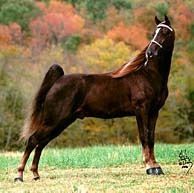Tennessee Walking Horse
N/A
Mon, 25th November, 2024 - 10:28 am GMT
Sponsor Ads:

Alternative Name
N/ABasic Info
The Tennessee Walking Horse generally ranges from 14.3 to 17 hands and weighs 900 to 1200 pounds. The modern Tennessee Walking Horse possesses a pretty head with small well place ears. The horse has a long sloping shoulder, a long sloping hip, a fairly short back and short, strong coupling. The bottom line is longer than the top line, allowing for a long stride. Tennessee Walking Horses come in all colors and a variety of patterns. The diverse color choices are sure to please any horse enthusiast. Different colors are not discriminated against. The Tennessee Walking Horse performs three distinct gaits: the flat foot walk, running walk and canter. These three are the gaits that the Tennessee Walking Horse is famous, with the running walk being an inherited, natural gait unique to this breed
Health
N/AHabitat
N/ABehavior
The Tennessee Walking Horse has impressed the nation with its gentle disposition and its kindly manner, and continues to prove itself as one of the most versatile horses in the land. This docile temperament, together with its smooth easy gaits, has caused it to be much in demand in all sections of the country. It serves nobly as an English or Western pleasure mount and has taken the young, the aged, the timid, as well as experienced riders along pleasant paths and trailsOrigin
TennesseeHistory
The Tennessee Walking Horse, a member of the light breeds of the equine family, is no mystery horse, nor is there anything of magic or difficult to understand about his makeup. It is a composite breed that evolved from the Narragansett Pacer, Canadian, Morgan, Standardbred, Thoroughbred and American Saddlebred. These bloods were fused into one animal in the middle Tennessee bluegrass region, resulting in one of the greatest pleasure, show and trail riding horses. The result, over countless years, was the Tennessee Walking Horse - the first breed of horse to bear a state name. For those who think the Walking Horse is comparatively new on the equine scene, pages of history reflect the strong influence this animal has had in the building of this country and in the daily lives of our forefathers. Mainly used for utility and riding stock, he gained wide popularity for this ease of gait and ability to stride faultlessly over hills and through the valleys of the rocky middle Tennessee terrain. Being used as a utility animal for all type of farm work, as well as family transportation and recreation, the old plantation-type horse was not trained for showing in those days -- its gait was naturally inherited. In 1885, a cross between a stallion called Allendorf, from the Hambletonian family of trotters, and Maggie Marshall, a Morgan mare, produced a black colt with a white blaze, off hind coronet and near hind sock, Black Allan, foal of 1886. He was later to be chosen by the Tennessee Walking Horse Breeders' Association as the foundation sire of the Tennessee Walking Horse and designated as Allan F-1. While the bloodlines of the Gray Johns, Copperbottoms, Slashers, Hals, Brooks and Bullett families ran thick and produced a type known as the Tennessee pacer prior to the arrival of Allan F-1 in Middle Tennessee, it was a cross between Allan and the Tennessee Pacer that produced today's Tennessee Walking Horse. The Tennessee Walking Horse has impressed the nation with its gentle disposition and its kindly manner, and continues to prove itself as one of the most versatile horses in the land. This docile temperament, together with its smooth easy gaits, has caused it to be much in demand in all sections of the country. It serves nobly as an English or Western pleasure mount and has taken the young, the aged, the timid, as well as experienced riders along pleasant paths and trails. The Tennessee Walking Horse is now in all parts of the country. No longer found only in Tennessee, registered Tennessee Walking Horses can be found in all fifty United States and several foreign countries. And since the organization of the Tennessee Walking Horse Breeders' Association in 1935, nearly 300,000 horses have been registered.Common Foods
grassSponsor Ads:
"The general who does not understand these, may be well acquainted with the configuration of the country, yet he will not be able to turn his knowledge to practical account." -- Sun Tzu, The Art of War
Tennessee Walking Horse
Coded by: BGID® | ALL RIGHTS RESERVED Copyright © 2000-2024
Disclaimer | Privacy | Report Errors / Contact | Credits
















